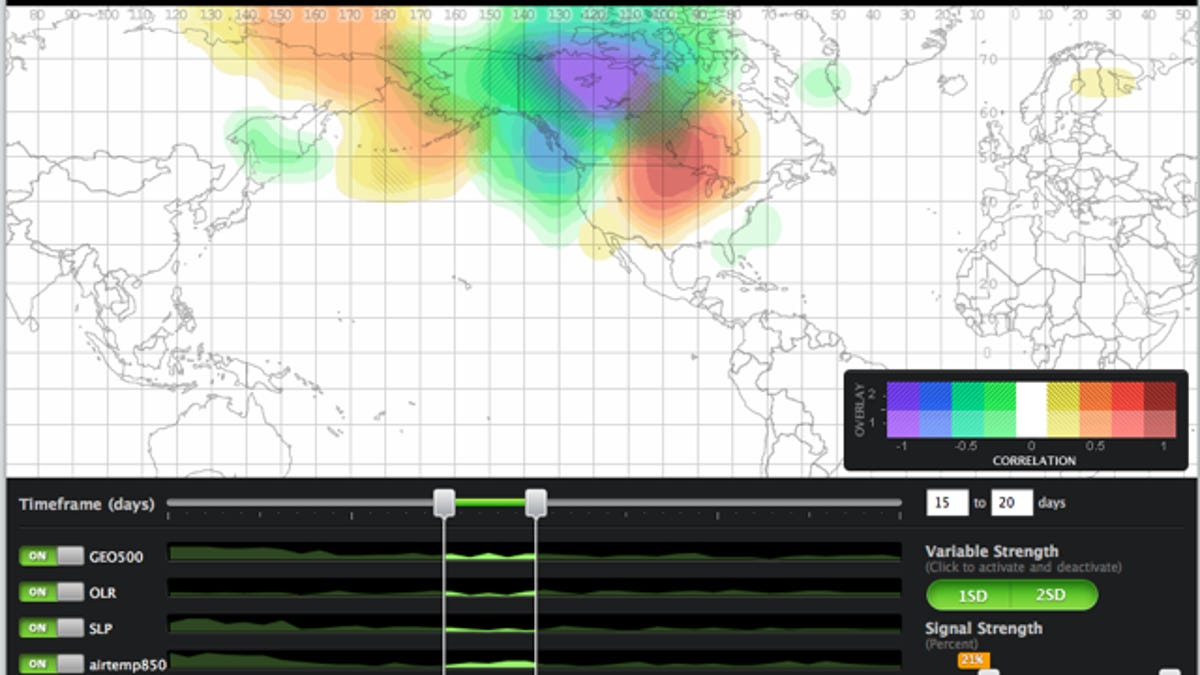EarthRisk crunches data to predict extreme weather
Building off years of atmospheric data, EarthRisk Technologies does long-range weather forecasts for extreme heat and cold events.

EarthRisk Technologies is mining years of weather data for profit.
The San Diego-based start-up today launched HeatRisk, a Web-based application designed to predict extreme heat events 30 to 40 days out. The target audience is meteorologists who work for energy companies or other organizations which need a long-range forecast to hedge their risk from extreme temperatures.
Over time, EarthRisk Technologies intends to design a product aimed at less technical users and investigate whether its research method can be applied to predicting extreme storms, according to President and Chief Science Officer Stephen Bennett. Its first product, released last year, is for analyzing the factors that lead to extreme cold events.
More researchers are tapping powerful computers and software able to present big sets of data to address environmental problems, such as air and water quality or extreme weather. EarthRisk Technologies originally began as a research project at the Scripps Institute of Oceanography in San Diego, but company founders saw there was a business opportunity buried in its research.
"We realized if we could write a software application around our research, it would increase the value of the underlying research tremendously," said Bennett. "The (corporate sponsors) said if you can put together a good application and continue to do cutting-edge research, we will be the first to sign up."
Three years ago, Scripps was approached by energy companies and hedge funds which deal in energy futures to see if there was a way to identify major weather events beyond the National Weather Service forecast. In addition to causing safety hazards, extreme weather throws energy markets out of whack by creating an imbalance between supply and demand.
A power generator, for example, could use HeatRisk to prepare for a coming heat wave by purchasing fuel for auxiliary generators to meet higher demand. Having a longer lead time than traditional forecasts gives energy buyers and traders an advantage, explained Bennett.
Right now, the people who use the software need to be skilled in meteorology and be comfortable analyzing atmospheric conditions directly. Eventually, the company hopes its software could be used by retailers, farmers, or municipalities which can use long-range forecasts to prepare for extreme temperatures, Bennett said.
Dominoes lining up
The accuracy of weather forecasting has improved over the past decade from supercomputers and simulation software, but the focus tends to be on shorter-term windows than what EarthRisk is doing, Bennett said. And rather than trying to forecast average temperatures, EarthRisk is seeking the factors that lead to specific extreme temperature events.
To build the application, researchers analyzed weather data going back to 1948 to identify the patterns that led up to extreme cold or heat. Each pattern is sort of like a domino and when enough of them line up, the software can help identify the probability of an extreme weather event, Bennett explained.
In a recent example, a combination of a large high-pressure system over Scandinavia and a low-pressure system in the Atlantic, followed by another system over the Solomon Islands pointed to a heat spike in the U.S.
People can use the analytical application through a Web browser and pay a fee for using it during a season and specific regions. A forecasting application could be ready in about six months, Bennett said.
Using software to dodge weather risk is new so it's still not clear there is a strong demand for it. But EarthRisk isn't the only company to use cloud computing and large amounts of data to hedge against extreme weather. Earlier this year, WeatherBill launched a service that gives farmers insurance against the effects of extreme weather by continuously analyzing weather data.

